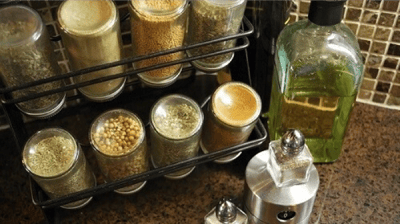The Best Plants to Help Keep Pests Away
Warmer weather has returned, which means more time spent enjoying the great outdoors. Unfortunately, relaxing in nature often brings with it the...
Manage your everyday finances with convenient accounts, flexible cards, and personalized service designed to fit your life.
At First Federal Bank, we offer flexible mortgage solutions for almost any situation, helping you secure the right financing for your dream home.
Business banking offers secure financial management, streamlined transactions, credit options, and tools to help businesses grow efficiently and sustainably.
2 min read
First Federal Bank : October 10, 2022 10:00:00 AM EDT

 When you want the meals you cook to taste good, reaching for the salt and pepper makes plenty of sense. But don’t stop with those common seasonings! Vibrant herbs and zesty spices abound at local grocery stores, online specialty shops, and perhaps even in your own yard or garden. Once you choose the right ones for your recipe, you’ll be well on your way to a unique and unforgettable flavor upgrade:
When you want the meals you cook to taste good, reaching for the salt and pepper makes plenty of sense. But don’t stop with those common seasonings! Vibrant herbs and zesty spices abound at local grocery stores, online specialty shops, and perhaps even in your own yard or garden. Once you choose the right ones for your recipe, you’ll be well on your way to a unique and unforgettable flavor upgrade:
Basil: Fresh basil leaves bring pleasant fragrance and piquant flavor to a wide range of dishes. Basil is especially effective when you add it to fresh tomato sauce right before serving with pasta. It’s also a key ingredient in pesto.
Cilantro: This love-it-or-hate-it herb is best known for the role its leaves and stems play in Mexican and Indian cuisine. Cilantro pairs well with lime and adds a strong, vibrant citrus-like flavor to dishes like fresh salsa, salad dressings, and tacos.
Cumin: Cumin imparts warm, earthy flavors to Mexican, Indian, and Mediterranean cuisines — and many other dishes, too. Some recipes call for it in seed form (often cooked in oil or roasted), but it’s more commonly incorporated in ground form.
Dried herbs
Some herbs make a great contribution when they’re dried. The Spruce Eats notes they’re especially well-suited for imparting flavor to a long-simmering or slow-cooked dish. That flavor is more concentrated than it is with fresh herbs, so you can use smaller quantities.
Fresh herbs
Both herbs and spices come from plants. Typically, though, herbs are the green or leafy parts. Many herbs contribute the best flavor when fresh. According to The Spruce Eats, they’re especially effective with salads and other uncooked dishes, or when added at the very end of the cooking process.
Oregano: With its sweet, spicy, and earthy taste, dried oregano is a popular and easily recognizable ingredient in taco seasoning, pizza sauce, and olive oil marinades. And it’s versatile enough to fit in with many other sauces, soups, dressings, and main dishes.
Paprika: Made from dried, crushed chili peppers, paprika is available in numerous mild, spicy, and smoked variants. Regular paprika can add a bit of extra bite and heat to stews, deviled eggs, and more. Smoked paprika imparts deep, meaty aromas and flavors to cooked meats, beans, vegetables, and other dishes.
Spices
Spices are plant-based like herbs, but according to Britannica, they’re more likely to consist of a seed, a berry, a root, or bark. They’re usually dried and most often sold either whole, crushed, or ground into a powder.
Spice and herb blends
Sometimes, instead of buying many individual herbs and spices for a recipe, it makes more sense to use a time-tested blend. For example, herbes de Provence combines rosemary, marjoram, thyme, savory, and other dried herbs to flavor stews and grilled meats. Garam masala flavors Indian dishes with a blend of ground spices like cinnamon, cardamom, cumin, coriander, nutmeg, and pepper. And Middle Eastern cuisine frequently incorporates za’atar, a mix of thyme, sumac, toasted sesame seeds, and other dried herbs and spices.
Thyme: When dried, thyme contributes a strong aroma and balanced flavor to soups, stews, and roasted meats. It’s also a great flavor enhancer for cooked tomatoes and beans.
Are you growing tired of the same old meals? Using just a few of the herbs and spices discussed here, you can introduce a whole new level of flavor and variety to the foods you eat every day.

Warmer weather has returned, which means more time spent enjoying the great outdoors. Unfortunately, relaxing in nature often brings with it the...

Whether you spend too much time on the couch, or are constantly on the go, you can make big gains when you commit to a regular walking routine....

Do you reach for your phone the moment you receive a notification? Do you often spend 30 minutes scrolling through social media when you only meant...